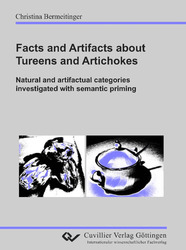| Fachbereiche | |
|---|---|
| Buchreihen (96) |
1378
|
| Nachhaltigkeit |
3
|
| Gesundheitswesen |
1
|
| Geisteswissenschaften |
2363
|
| Medienwissenschaften | 16 |
| Theologie | 57 |
| Philosophie | 102 |
| Rechtswissenschaft | 422 |
| Wirtschaftswissenschaften | 850 |
| Sozialwissenschaften | 416 |
| Sportwissenschaften | 48 |
| Psychologie | 233 |
| Pädagogik | 190 |
| Geschichtswissenschaften | 182 |
| Kunstwissenschaften | 110 |
| Kulturwissenschaften | 166 |
| Literaturwissenschaften | 116 |
| Sprachwissenschaften | 88 |
| Naturwissenschaften |
5406
|
| Ingenieurwissenschaften |
1791
|
| Allgemein |
98
|
|
Leitlinien Unfallchirurgie
5. Auflage bestellen |
|
Erweiterte Suche
Facts and Artifacts about Tureens and Artichokes
Natural and artifactual categories investigated with semantic priming
Christina Bermeitinger (Autor)Vorschau
Inhaltsverzeichnis, Datei (39 KB)
Leseprobe, Datei (75 KB)
Semantic memory is one of the most debated topics in contemporary neuropsychology. The first and foremost aim of the present work was to combine two lines of research on semantic memory. Originally, the first line comes from lesion patients and was then further explored with healthy subjects, that is the distinction of natural and artifactual categories. The second line of research comes from cognitive psychology. Here, a paradigm is frequently used to investigate the structure of and processes in semantic memory, that is the semantic priming paradigm. In the present work, this paradigm was used and natural versus artifactual categories were tested. Interestingly, an interaction with participants’ sex was found. Females showed strong positive priming effects (i.e., faster reactions to a second target-word preceded by a related first word compared to an unrelated first word) for natural categories but no or even reversed priming effects for artifactual categories. In contrast, males showed approximately equal sized positive priming effects for natural and for artifactual categories. This finding was further investigated using common techniques from (neuro-)psychology. First, a lateralized presentation of stimuli was used to explore the involvement of both hemispheres. Second, event-related potentials of the initial finding were analyzed. The results of these experiments were evidence that females and males can use the same underlying neurophysiological processes and that the sexes do not differ in their fixed underlying representations of natural and artifactual categories. Further experiments were conducted which induced a specific focus on perceptual or functional features of objects in general. These experiments showed that females and males most probably differ in their preferred processing modes but that females and males are able to use both processing modes. Furthermore, the experiments showed that semantic priming effects can be experimentally manipulated and hinge on an overlap of category relevant features. In turn, this overlap can be changed by the current top-down focus of a person which is either habitually set or experimentally induced.
| ISBN-13 (Printausgabe) | 3867278989 |
| ISBN-13 (Printausgabe) | 9783867278980 |
| ISBN-13 (E-Book) | 9783736928985 |
| Sprache | Englisch |
| Seitenanzahl | 172 |
| Auflage | 1 Aufl. |
| Band | 0 |
| Erscheinungsort | Göttingen |
| Promotionsort | Universität Saarbrücken |
| Erscheinungsdatum | 20.02.2009 |
| Allgemeine Einordnung | Dissertation |
| Fachbereiche |
Psychologie
|








